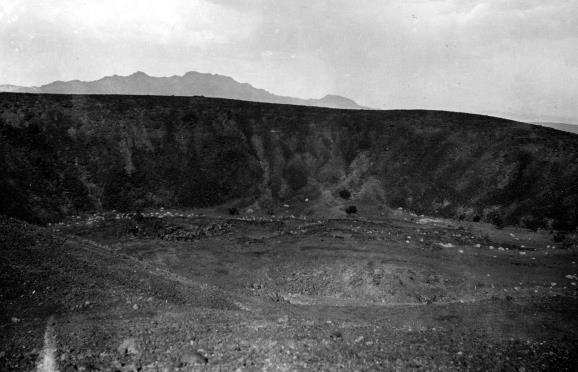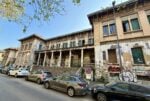Miguel Fernández De Castro / Lydia Ourahmane – Crater

Mostra doppia personale
Comunicato stampa
The surface forms of the Elegante Crater in Mexico and the Laghouat Crater in Algeria are uncannily similar, although the former was made through a volcanic eruption and the latter caused by meteor impact. These two opposing forces – an ejection from the centre of
the earth and the impact collision of a foreign material – both altered the tissue of the surface, and created the same hole and crown at each respective location.
Working across a variety of mediums including sculpture, installation, photography and video, artists Miguel Fernández de Castro and Lydia Ourahmane both generally address place and landscape, usually the sites of their respective origins; Fernández de Castro the Sonoran Desert in Northern Mexico and Ourahmane the regions surrounding Oran, Algeria. While geographically disparate, both of these arid sites are bound and shaped by complicated economic configurations, geopolitical turmoil, violence and social unrest. To the artists the imprints of these conflicts can be read through the materiality of the land, their impressions present in the dirt, or the water, or the exhausted mine.
In much of their respective practices, experientially being on-site is key, and as such they are both commonly researching in the field, seeking access to difficult sites or moving a material from one location to another, and a translation of this activity is usually present within their exhibitions. In this case, Crater, the collaborative work on display, wasn’t formed by a realised journey that the artists embarked on together, but rather is formed by an interrogation into the process of projecting. The artists ask what is the point in accessing spaces physically if all we have projected upon them already exists? Does the act of witnessing, or being present, only function as an affirmation? As such the gallery itself becomes an enactment of this line of inquiry, and provides a site and surface to reflect upon expectations, experiences, and access or the mutual lack thereof.
*The exhibition is curated by Cory Scozzari.
Miguel Fernández de Castro (b. 1986, Sonora, MX) Works on long term discursive research projects that involve writing and visual arts. His work has been shown at The Wren Library, Cambridge; MOCA Arizona; Artium, Vitoria; Museo Carrillo Gil, CDMX (2017); Proyecto Paralelo, CDMX (2015); Casa del Lago, UNAM (2015-2016); Museo de Arte Moderno de México - MAM (2014); Museum of Anthropology of Vancouver - MOA (2013); Museum of Latin American Art - MoLAA (2013); ATEA (2012/2013); Bikini Wax, CDMX (2013); Museo de Arte Contemporáneo - MARCO, Monterrey (2012); The Collaborative- MoLAA, Los Angeles (2012); Museo de San Ildefonso, CDMX (2013); Jaus Gallery, Los Angeles (2011); among others. He obtained the Acquisition Prize of the X Bienal FEMSA, Monterrey (2012); he was a recipient of the Young Creators Grant, FONCA, México (2011-2012) and The Tierney Fellowship, New York (2010). He published the book El desplazamiento (T-E-E, Guadalajara, 2012) and developed the project A micro history of YouTube in Beirut (2014) during Home Workspace Program at Ashkal Alwan, Beirut (2013-2014). Recently he was artist in residence in PAOS, Guadalajara, where he published the book Llanuras elementales (T-E-E, PAOS, 2017) and speaker at Trinity College, Cambridge, where he presented the installation Limits and domains: the gift at The Wren Library.
Lydia Ourahmane (b. 1992, Saϊda, Algeria) lives and works between London and Oran. Forthcoming exhibitions include: Solo Exhibition, Chisenhale Gallery, London; 2018 New Museum Triennial, The New Museum of Contemporary Art, New York; a good neighbour, 15th Istanbul Biennial; How to Disappear Completely, Garage Rotterdam, Netherlands (all 2017); The end of the World, Luigi Pecci Center for Contemporary Art, Italy; Social Calligraphies, Zachęta National Gallery of Art, Warsaw; that a body knows regardless, Interstate Projects, New York (all 2016); The Third Choir, Art Berlin Contemporary, Berlin; Territoires Arabes, Palais de La Culture, Algeria; (all 2015); and Bloomberg New Contemporaries, Institute of Contemporary Arts, London (2014).
Cory Scozzari (b. 1988, Florida, USA) is a curator and artist. He is the founder and director of Cordova, a curatorial project initiated in 2016 in Vienna and currently located in Barcelona. From 2015-2017 he worked as assistant curator at Thyssen-Bornemisza Art Contemporary. He was a founding member and co-director of Jupiter Woods, London/Vienna from 2014–16. He received his BFA in photography from SCAD in Savannah, Georgia in 2010 and a MFA in curating at Goldsmiths, University of London in 2015. Recently he co-edited two publications, Allan Sekula: OKEANOS and Mario García Torres: An Arrival Tale, both published by TBA21 and Sternberg Press. He, together with Filipa Ramos, co-curated the “Sekula beyond Sekula” film program as part of “Allan Sekula: OKEANOS” at TBA21. Recent exhibitions include: Mohammed Abd Alwasi: The Memory of Hunger and Holly White: ORANGE WORLD, both at Cordova in Barcelona.
***
Le fattezze e le forme del cratere El Elegante in Messico e del cratere Laghouat in Algeria sono incredibilmente molto simili, nonostante il primo sia originato da una eruzione vulcanica e il secondo invece in seguito all'impatto di un meteorite con la terra. Queste due forze opposte – un'eiezione dal centro della terra e una collisione con materiale estraneo – hanno entrambe alterato il tessuto della superficie, arrivando a creare nei rispettivi luoghi una stessa enorme corona, uno stesso cratere.
Spaziando tra una molteplicità di medium, quali scultura, installazione, fotografia e video, gli artisti Miguel Fernández de Castro e Lydia Ourahmane si rivolgono entrambi a siti naturali e paesaggi, scegliendo di solito i luoghi delle loro rispettive regioni di provenienza, il Deserto di Sonora nel Messico settentrionale per Fernández de Castro, e per Ourahmane la regione di Orano, in Algeria. Anche se si tratta di aree geografiche molto diverse, questi due siti aridissimi sono altrettanto segnati da dinamiche economiche complicate, questioni geopolitiche spinose, violenza e disordini sociali. La sensibilità dei due artisti trova traccia di questi conflitti nella materialità della terra, quasi impressa nel fango, nell'acqua, o nelle cave abbandonate.
La chiave di gran parte della loro pratica artistica è rappresentata dall'esperienza di presenza sul posto, e per questo sono insieme impegnati in una ricerca comune sul campo, in siti dall'accesso complicato, nei quali essi dislocano materiali, trasferendoli da un posto all'altro; una traslazione di questa attività è spesso presente all'interno delle loro esposizioni. Nel caso di Crater, l'opera in mostra frutto di una stretta collaborazione, non nasce da un viaggio reale che Fernández de Castro e Ourahmane hanno intrapreso insieme, ma piuttosto scaturisce da un esame dei nostri processi proiettivi. Gli artisti si chiedono a che serve accedere fisicamente agli spazi se tutto ciò che abbiamo proiettato su di essi esiste già? L'atto di testimonianza, e la reale presenza fisica, fungono unicamente come affermazione? In tal senso la galleria stessa diventa un'emanazione di questa linea di indagine, e si lascia percorrere come sito e superficie capace di riflettere sulle aspettative, le esperienze, la presenza e accesso ai luoghi, o al contrario sulla mancanza di tutto questo.
*La mostra è curata da Cory Scozzari
Miguel Fernández de Castro (nato a Sonora, Messico, nel 1986) lavora su progetti di ricerca a lungo termine che coinvolgono la scrittura e le arti visive, in una prospettiva dialogica. Le sue opere sono state esposte principalmente alla Wren Library, Cambridge; MOCA Arizona; Artium, Vitoria; Museo Carrillo Gil, Città del Messico (2017); Proyecto Paralelo, Città del Messico (2015); Casa del Lago, UNAM (2015-2016); Museo de Arte Moderno de México - MAM (2014); Museum of Anthropology of Vancouver - MOA (2013); Museum of Latin American Art - MoLAA (2013); ATEA (2012/2013); Bikini Wax, Città del Messico (2013); Museo de Arte Contemporáneo - MARCO, Monterrey (2012); The Collaborative- MoLAA, Los Angeles (2012); Museo de San Ildefonso, Città del Messico (2013); Jaus Gallery, Los Angeles (2011). Tra i vari premi è stato insignito dell'Acquisition Prize della X Biennale FEMSA, Monterrey (2012); ha inoltre ottenuto il Young Creators Grant, FONCA, Messico (2011-2012) e il Tierney Fellowship, New York (2010). Al suo attivo, ricordiamo la pubblicazione del libro El desplazamiento (T-E-E, Guadalajara, 2012) e il progetto A micro history of YouTube in Beirut (2014) per l'Home Workspace Program, presso l'associazione Ashkal Alwan, Beirut (2013-2014). Di recente è stato artista residente al PAOS, Guadalajara, per il quale ha pubblicato il libro Llanuras elementales (T-E-E, PAOS, 2017), ha infine tenuto conferenze al Trinity College, Cambridge, dove ha presentato l'installazione Limits and domains: the gift alla Wren Library.
Lydia Ourahmane (nata a Saϊda, Algeria, nel 1992) vive e lavora tra Londra e Orano. Di seguito le sue esposizioni: mostra personale, Chisenhale Gallery, Londra; 2018 New Museum Triennial, The New Museum of Contemporary Art, New York; a good neighbour, 15a Biennale di Istanbul; How to Disappear Completely, Garage Rotterdam, Paesi Bassi (per tutto il 2017); The end of the World, Centro per l'arte contemporanea Luigi Pecci, Italia; Social Calligraphies, Zachęta National Gallery of Art, Varsavia; that a body knows regardless, Interstate Projects, New York (per tutto il 2016); The Third Choir, Art Berlin Contemporary, Berlino; Territoires Arabes, Palais de La Culture, Algeria; (per tutto il 2015); e Bloomberg New Contemporaries, Institute of Contemporary Arts, Londra (2014).
Cory Scozzari (nato in Florida, USA, nel 1988) è artista e curatore. Ha fondato la galleria Cordova, di cui è anche direttore, un progetto curatoriale iniziato nel 2016 a Vienna, e che attualmente ha sede a Barcellona. Nel periodo 2015-2017 ha lavorato come assistente curatore presso il Thyssen-Bornemisza Art Contemporary. Nel biennio 2014–2016 ha collaborato alla creazione del Jupiter Woods, Londra/Vienna, di cui è stato codirettore. Nel 2010 ha ottenuto il BFA in fotografia allo SCAD di Savannah, Georgia e nel 2015 l'MFA come curatore presso la Goldsmiths, University of London. Recentemente ha curato in collaborazione con altri due pubblicazioni, Allan Sekula: OKEANOS e Mario García Torres: An Arrival Tale, entrambi pubblicati da TBA21 e Sternberg Press. Insieme a Filipa Ramos, è stato curatore di “Sekula beyond Sekula” programma di film nella cornice di “Allan Sekula: OKEANOS”, TBA21. Tra le mostre più recenti, ricordiamo: Mohammed Abd Alwasi: The Memory of Hunger e Holly White: ORANGE WORLD, entrambe allestite alla galleria Cordova di Barcellona.



